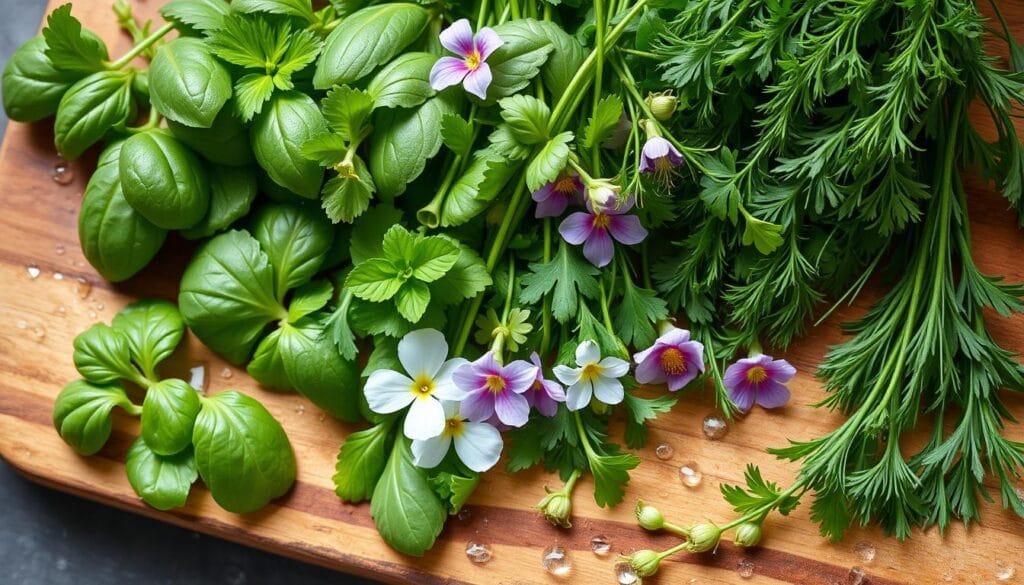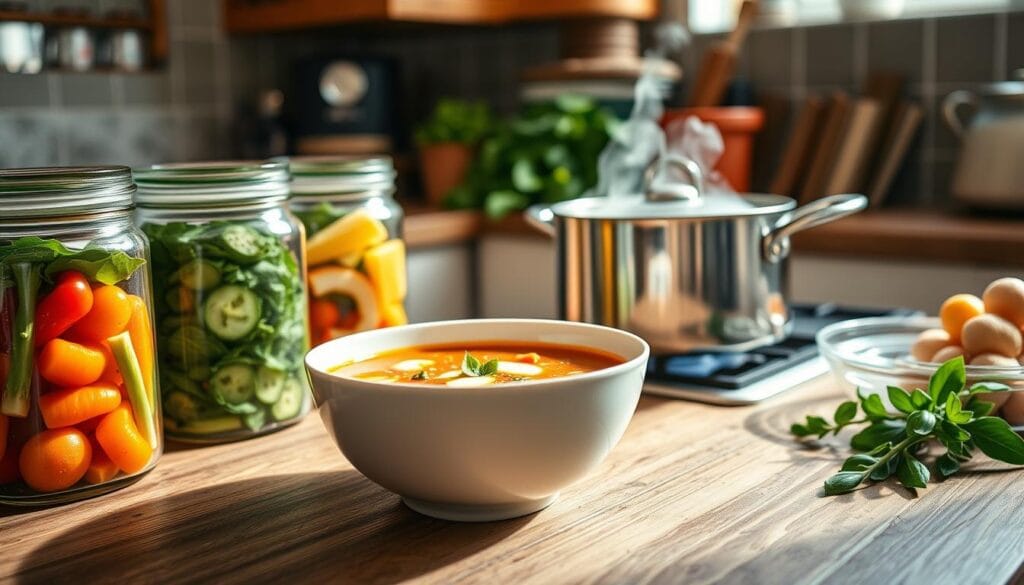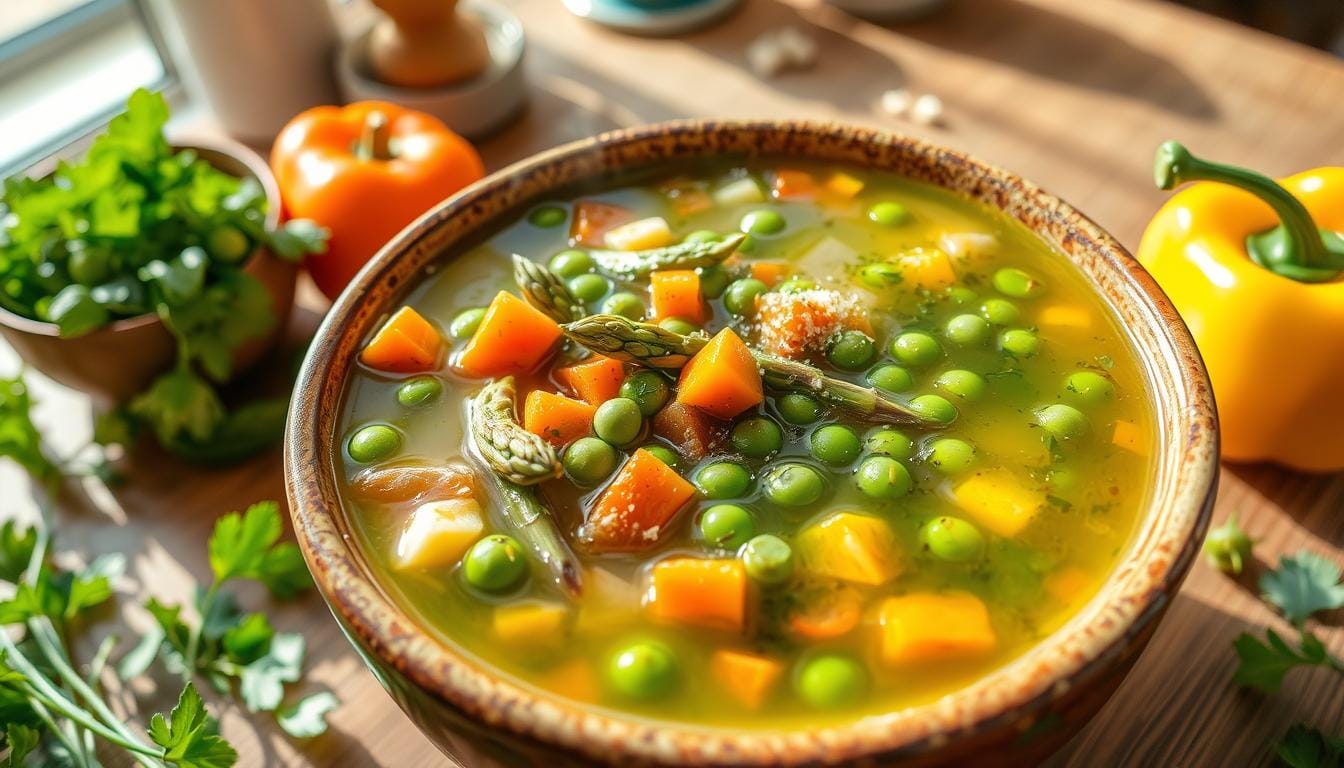As spring arrives, it’s time to start cooking with a delicious spring vegetable soup. This meal is both comforting and nutritious. It highlights the best of the season’s fresh produce.
This soup is more than just a meal. It’s a celebration of the season’s best ingredients. It combines vibrant veggies that are full of nutrients and taste amazing. By choosing seasonal produce, you get a better dining experience. You also help local farmers and save money on fresh ingredients.
If you love cooking at home or need a healthy meal, this soup is for you. It’s easy to make and packed with vitamins and minerals.
Table of Contents
Understanding the Essence of Seasonal Spring Soups
Spring brings a vibrant array of seasonal produce. This transforms ordinary soups into extraordinary culinary experiences. Exploring fresh ingredients from local farmers markets unlocks a world of flavor and nutrition.
Embracing seasonal produce connects us with nature’s rhythm. Your spring vegetable soup becomes more than just a meal. It’s a celebration of nature’s bounty.
Benefits of Using Fresh Spring Produce
Choosing fresh ingredients from farmers markets offers many advantages:
- Peak nutritional value at harvest time
- Enhanced natural flavors
- Support for local agricultural communities
- Reduced environmental impact
Key Nutritional Components
Spring vegetables are packed with nutrients. Asparagus, carrots, and green onions boost your immune system and support health.
“Eating seasonal produce is like receiving a natural vitamin supplement directly from the earth.” – Local Farmer’s Wisdom
Seasonal Availability Guide
Knowing when vegetables are at their prime is key. Here’s a quick guide to spring’s vegetable superstars:
- Asparagus: March to May
- Spinach: April to June
- Spring Peas: May to July
- Green Onions: March to May
By selecting seasonal produce, you’re not just preparing a soup. You’re crafting a nutritious, flavorful experience that connects you with nature’s rhythms.
Essential Ingredients for Your Spring Vegetable Soup
Starting a spring vegetable soup is all about picking the freshest garden veggies. Your dish will burst with life from the vibrant seasonal produce of spring.
Choosing the right mix of ingredients is crucial for a great soup. Let’s look at the key veggies that make your soup both healthy and tasty:
- Leeks: Mild and slightly sweet, providing a delicate onion-like flavor
- Asparagus: Tender and packed with nutrients
- Fresh peas: Bright green and bursting with sweetness
- Kale: Robust and nutrient-dense green
- Celery: Adding a crisp texture and aromatic base
When picking your veggies, go for the freshest and what’s in season. Local farmers’ markets are great for finding the best spring produce for your dishes.
“The secret to a great soup is using vegetables at the peak of their season.” – Chef’s Wisdom
To get the most flavor and nutrition, follow these quick tips:
- Wash vegetables thoroughly
- Chop into uniform sizes for even cooking
- Use light sautéing to enhance natural flavors
Your spring vegetable soup will not only taste amazing but also be a nutritional powerhouse. It’s full of vitamins, minerals, and antioxidants that boost your health.
The Art of Preparing Fresh Vegetables for Soup
Making a tasty spring vegetable soup begins with preparing your garden veggies well. Handling fresh ingredients right brings out the best flavor and nutrition in every spoonful.
When working with fresh ingredients, cleanliness and precision are key. Your way of preparing veggies can greatly affect the soup’s taste and texture.
Proper Cleaning Techniques
- Rinse garden vegetables under cool running water
- Use a soft vegetable brush for root vegetables
- Pat dry with clean kitchen towels
- Remove any visible dirt or debris
Cutting and Chopping Methods
Vegetables should be cut to the same size for even cooking. Professional chefs say to cut all veggies to about the same size.
| Vegetable Type | Recommended Cut Size |
|---|---|
| Carrots | ½-inch cubes |
| Celery | ¼-inch slices |
| Sweet Potatoes | ¾-inch chunks |
| Bell Peppers | ½-inch strips |
Storage Tips for Maximum Freshness
Storing your fresh ingredients right can keep them fresh longer. Keep cut veggies in airtight containers in the fridge. Use them within 2-3 days for the best taste.
“Fresh vegetables are the heart of any great soup. Treat them with care, and they’ll reward you with incredible flavor.” – Culinary Expert
By using these preparation tips, you’ll turn your garden veggies into a delicious, healthy spring vegetable soup. It will highlight the season’s freshest ingredients.
Spring Vegetable Soup: Step-by-Step Recipe
Making delicious light soups with spring recipes needs care and precision. Your homemade vegetable soup will turn fresh seasonal ingredients into a nutritious meal that pleases the senses.
Now, let’s explore the key steps to making your ideal spring vegetable soup:
- Prepare Your Ingredients
- Chop 6 fresh vegetables: onion, garlic, celery, carrots, potatoes, and kale
- Measure 4.5 cups of vegetable broth
- Gather seasoning ingredients: sea salt, black pepper, lemon juice
- Sauté Aromatics
- Heat 3 tablespoons olive oil in a large pot
- Cook onions and garlic for 5 minutes until fragrant
- Build Your Soup
- Add carrots, celery, and potatoes
- Cook for 10 minutes
- Pour in vegetable broth
- Simmer for 15 minutes
“A great soup tells a story of its ingredients and the love put into its creation.”
To finish your spring recipes, add one 15-ounce can of butter beans and your greens. Cook for another 5-10 minutes. End with fresh parsley and a squeeze of lemon juice for a burst of flavor.
| Nutritional Highlights | Per Serving |
|---|---|
| Calories | 137 |
| Protein | 3.2g |
| Dietary Fiber | 4.9g |
Your light soups are now ready to serve! Enjoy with crusty bread for a full meal that celebrates spring’s fresh offerings.
Mastering the Perfect Broth Base
Making a tasty spring vegetable soup begins with a rich, flavorful vegetarian broth. The broth’s taste and nutrition are key. You can make your own or buy it, each with its own benefits.
Homemade vs. Store-bought Broth Options
When making your spring vegetable soup, you have two main broth choices:
- Homemade vegetarian broth: Maximum flavor control
- Store-bought vegetarian broth: Convenient and time-saving
“The secret to an exceptional spring vegetable soup lies in its broth.” – Culinary Chef
Selecting the Best Vegetarian Broth
For store-bought options, choose brands with mushrooms. These broths have deeper, richer flavors that make your soup better.
| Broth Type | Flavor Intensity | Preparation Time |
|---|---|---|
| Homemade Vegetarian Broth | High | 60-90 minutes |
| Store-bought Vegetarian Broth | Medium-High | Instant |
Seasoning and Flavor Enhancement
Improve your vegetarian broth’s taste with these easy steps:
- Add fresh herbs like thyme and rosemary
- Incorporate roasted garlic
- Use nutritional yeast for depth
- Include a splash of white wine
Pro tip: Taste and adjust seasonings gradually to create a perfectly balanced spring vegetable soup broth.
Incorporating Seasonal Herbs and Aromatics

Spring recipes burst with life thanks to fresh ingredients. Herbs are key in making your vegetable soup stand out. Choosing the right herbs can take your dish to the next level.
When picking herbs for your spring vegetable soup, consider these:
- Parsley: Bright and crisp, adds a fresh green note
- Dill: Delicate with a subtle tangy flavor
- Thyme: Earthy and slightly minty undertones
- Chives: Mild onion-like essence
To get the most flavor, use these herb tips:
- Add delicate herbs like parsley and dill in the last 2-3 minutes of cooking
- Crush hardier herbs like thyme to release essential oils
- Chop herbs just before adding to preserve their vibrant flavor
“The secret to an exceptional soup lies in the harmonious blend of fresh herbs and seasonal vegetables.” – Chef Maria Rodriguez
Pro tip: Grow your own herb garden. A small container on your windowsill can give you fresh herbs. This ensures your spring recipes have the best flavor and nutrition.
Creating the Perfect Texture and Consistency
Making the perfect texture for your light soups is all about technique and understanding. Spring vegetable soup has many ways to get a consistency that pleases your taste buds.
Mastering Blending Methods
Blending is key when making your spring vegetable soup. It helps achieve a smooth, creamy texture. Chefs suggest different blending methods:
- Partial blending: Keep some vegetables whole for added texture
- Full blending: Create a silky-smooth consistency
- Immersion blender technique: Blend directly in the pot for convenience
Natural Thickening Approaches
Thickening your soups doesn’t need heavy cream or hard methods. Natural ingredients can make your spring vegetable soup rich and satisfying:
- Potatoes: Add creaminess and substance
- White beans: Provide protein and smooth texture
- Pureed vegetables: Create natural thickness
“The secret to a perfect soup is balancing texture and flavor.” – Culinary Expert
Blend about three-quarters of your soup. Keep some vegetable chunks for a rustic feel. This way, your spring vegetable soup stays light but hearty, celebrating fresh seasonal flavors.
| Blending Technique | Texture Result | Recommended For |
|---|---|---|
| Partial Blending | Chunky, Varied | Rustic Styles |
| Full Blending | Smooth, Creamy | Refined Presentations |
| Immersion Blender | Customizable | Home Cooking |
Remember, the secret to a great spring vegetable soup is trying different techniques to find what you like best.
Health Benefits and Nutritional Value
Your spring vegetable soup is more than just tasty. It’s packed with nutrients that can change your diet for the better. This plant-based dish is full of vitamins, minerals, and antioxidants. These help keep you healthy and feeling good.
Spring vegetables make this soup a superfood. Every spoonful brings amazing health benefits. Let’s look at what makes it so special:
- Boosts immune system functionality
- Supports digestive health
- Reduces inflammation naturally
- Provides essential micronutrients
Vegetables like asparagus and broccoli add a lot of nutritional value. A single serving gives you big health benefits:
| Vegetable | Key Nutrients | Health Benefits |
|---|---|---|
| Asparagus | Vitamin K (57% RDI), Folate (34% RDI) | Supports bone health, reduces inflammation |
| Broccoli | Vitamins K, C, E, Folate | Enhances cellular protection, boosts immunity |
| Mushrooms | Selenium, Potassium, Riboflavin | Low-calorie nutrition, supports metabolism |
“Nutrition is the foundation of health, and spring vegetable soup is a delicious way to nourish your body.” – Nutrition Expert
Your spring vegetable soup is more than a meal. It’s a nutrient-rich, plant-based dish that supports your health. By adding these vibrant ingredients, you’re choosing a healthy path for your future.
Storage and Reheating Guidelines
Keeping your spring vegetable soup fresh is key. You need to know how to store and reheat it right. This way, you can enjoy your soup for days.

Refrigeration Best Practices
Store your soup in an airtight container in the fridge. Here’s what to do:
- Cool the soup completely before storing
- Use clean, sealed containers
- Refrigerate within 2 hours of cooking
- Consume within 4-5 days
Freezing Instructions
Freezing your soup keeps it fresh for longer. It also keeps the taste great.
| Freezing Method | Details |
|---|---|
| Maximum Storage Time | Up to 6 months |
| Recommended Container | Freezer-safe containers with 1-inch headspace |
| Portion Recommendation | Use 2-cup freezer trays for individual servings |
Reheating Tips
Here’s how to reheat your soup:
- Thaw gradually in the refrigerator overnight
- Reheat on stovetop over medium heat
- Stir regularly to maintain consistency
- Microwave at 50% power for about 8 minutes
Pro Tip: Avoid freezing soups with pasta, potatoes, or dairy to prevent texture changes.
Remember that some ingredients like wild rice and brown rice maintain better texture when frozen compared to other starches.
Serving Suggestions and Accompaniments
Make your spring recipes shine with the right accompaniments. These can turn your plant-based dishes into unforgettable meals. Your spring vegetable soup needs thoughtful friends that boost both taste and health.
Here are some great ideas to enhance your dining experience:
- Crusty artisan bread for dipping
- Whole-grain crackers with herbs
- Fresh spring salads with seasonal greens
- Crisp roasted vegetable sides
Adding garnishes can really make your soup pop. Sprinkle fresh herbs like chives, dill, or parsley for color and scent. A bit of extra-virgin olive oil or Greek yogurt adds a fancy touch.
“The right accompaniment transforms a simple soup into a culinary adventure.” – Chef’s Wisdom
For those watching their protein, try these options with your spring vegetable soup:
- Grilled tofu cubes
- Quinoa salad
- Roasted chickpeas
- Soft-boiled eggs
Get creative with your spring vegetable soup. Mix different textures, temperatures, and flavors for a meal you’ll remember.
Variations and Adaptations for Dietary Needs
Making a versatile spring vegetable soup lets you cater to many dietary needs. Your vegetarian broth is a great base for various changes. These changes ensure the soup stays tasty and meets different nutritional needs.
- Vegan Version: Swap out dairy for coconut milk or nutritional yeast
- Gluten-Free Option: Try using quinoa instead of pasta
- Low-Sodium Adaptation: Choose fresh herbs and use less premade broth
- Protein-Enhanced Variation: Add lentils or beans for more protein
“Adaptability is the secret ingredient in creating a truly remarkable soup.” – Culinary Wisdom
Your spring vegetable soup can change to fit specific dietary needs. It keeps the taste and nutrition great. About 90% of adults don’t eat enough veggies. This flexible recipe is a great way to get more veggies in your diet.
| Dietary Need | Recommended Adaptation | Nutritional Impact |
|---|---|---|
| Vegan | Replace animal products with plant-based alternatives | Reduced cholesterol, increased fiber |
| Gluten-Free | Use alternative grains or remove wheat-based ingredients | Improved digestibility |
| Low-Sodium | Reduce premade broth, use fresh herbs | Decreased sodium intake |
Try mixing up the veggies and proteins to make a soup that fits your needs. It’s a fun way to enjoy fresh, seasonal ingredients.
Conclusion
Making a spring vegetable soup turns your kitchen into a celebration of fresh produce. You’ve learned how to make a nutritious meal that shows off spring’s best. Your soup is not just tasty but also packed with nutrients from various veggies.
This journey through spring vegetable soup recipes is more than just food. It connects you to local farms, seasonal eating, and healthy choices. Every spoonful is a chance to get creative in the kitchen and stay healthy. You can change up the ingredients and methods to fit your taste and diet.
Cooking is always an adventure. Try new veggies, herbs, and ways of cooking to make your soup your own. This recipe is great for any meal, big or small. Enjoy the flavors, health perks, and fun of cooking with fresh, seasonal ingredients.

